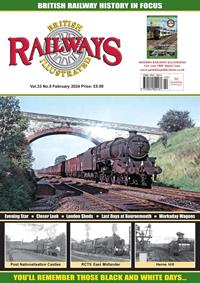|
|
Contents Listing - Articles & Features in this issue
Main Features: STOURBRIDGE SHED - Notes by Ian Sixsmith - Simple, straightforward and uncomplicated was Stourbridge shed, though the detail of its history was anything but - it was notable really for the 'might-have-beens' rather than anything else. A bread and butter shed, it was to be transformed from poky, ill-lit four road shack to a wonder of the age, a vast roundhouse complex to rival even Old Oak Common. Unfortunately, the Great War intervened and when the project was revived in the 1920s the railways were long past their turn of the century zenith (though no one recognised it as zenith at the time). Stourbridge eventually emerged as a single roundhouse and in the | many years remaining to it got on with the job in hand quietly and purposefully, playing its part in the general run of the mill railway work around the district. Unsung, like so many others, but vital nonetheless. BRILL seeks to chart the story of many sheds such as these, but it is difficult now to find staff who knew such places. Did YOU work at a steam shed (of any Region) and can you describe its working, link structure and so on? BRILL would be pleased to talk to you! FOG ON THE TYNE By Jim Smith - Lurking, unsuspected, at the mouth of the Tyne was a fantastical private railway system,eighty miles or more with its own fleet of locos, an engine shed and no less than ten of its own signalboxes - the complex of lines owned by the Tyne Improvement Commission (TIC). Into this labyrinth came regular North Eastern Region trains, including The fttoreemanfrom Kings Cross, full of passengers (already queasy at the thought) ready to dare the passage of the North Sea to Scandinavia. 2-6-2Ts threaded the lines down to the wharves of the Bergen Line and the Fred Olsen Line. The sea journey was not one to be lightly undertaken and after many a rough trip from Oslo, Stavanger or Bergen, the 'Tyne Commission Quay' was a sight for sore eyes indeed. They were strange times, the early 1950s-one ship, M.V. VENUS, had actually been sunk in the Second World War but had been recovered and refitted. This was not the sort of encouraging snippet to impart to your average sea-sick traveller... DEATH OF A BRIDGE - More West Coast civil engineering, farther to the north this time, than Peter Coster's recent efforts in BRILL. Some four years on from the Euston-Liverpool/Manchester electrification, work began again, onwards from Weaver Junction up to Glasgow, chasing the M6. There was a price to pay beyond money, and it was paid in terms of the railway's soul - the semaphore signalling and much of the paraphernalia left over from the age of steam. Among many other things, the restricted structure gauge doomed a legion of attractive, worthy, bridges, turning so many elegant arches into mere slabs. Features: DOWN AND OUT - Within a few short years of their appearance in 1955 all ten Crosti 9Fs were dumped out of use at their 'home' shed Wellingborough (a home which did not welcome them in the slightest and fervently desired their removal) and even in these short years they had spent much of their time away at Crewe Works. Some of them stayed dumped for years... LAST DAYS - An end to the black and white days. RETURN TO EDEN - Photographs by George Heiron - Return to the trees and turrets of Edinburgh, perfect stage for Gresley Pacifies, gliding beneath. MANY MEETINGS - Locomotives and trains of all four pre-nationalisation companies met here on a peculiar mix of freight, express passenger and shunting work - not forgetting the London Transport electric trains... PLEASE HANDLE WITH CARE - So much traffic went by rail that it takes a wrench of the imagination to envisage it all. Nothing was too small or inconvenient and it was precisely this range of 'ordinary' produce that so helped to make traffic figures in country districts - that did not rely on some bulk mineral or manufacture - so healthy. Once the flowers and the fish, the cabbage and the carrots, the bicycles and the bedsteads went, there was nothing to put on the London-bound vans. THE CIVIL ENGINEER'S COLLECTION - More black and white in colour from BRILL. Cover photograph: more of the joys of Waverley, afforded something of a showcase this issue (and last, too). CALL BOY, a Haymarket A3, waits to leave with a Dundee express in July 1950. George Heiron. Regular Features: FOURUM - Studying STURDEE - Photographs by Paul Cotterell - A comprehensive portrait of Jubilee 45647 STURDEE, late in the day but with its head still held high. Careful engine-picking reveals many things-a substitute nameplate is only the most obvious WAR REPORT - Southern Home Guard - By D.W. Winkworth - With defeat in France, Britain's fortunes in the Second World War were at a low ebb indeed, yet morale was not. Instead, all thought was of how to fight back, and in this desperate time the Home Guard was formed. Anthony Eden's radio broadcast of 14 May announced the formation of Local Defence Volunteers to defend key points near their homes, and from this, by the end of June, arose a system of armed patrols at 268 points oh the railway, with many other unarmed patrols. A scheme for six battalions was drawn up, approved by the War Office, and duly made into Home Guard battalions. A READER WRITES A LIFE OF STEAM
Article Snippets
Awaiting Entry
Adverts and Links based on this content
Advertisement



